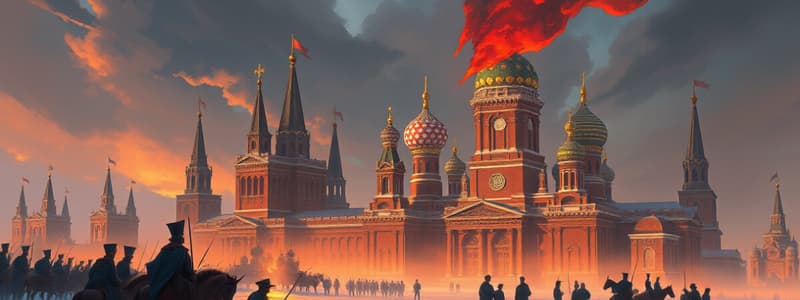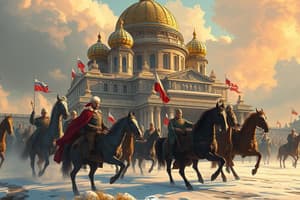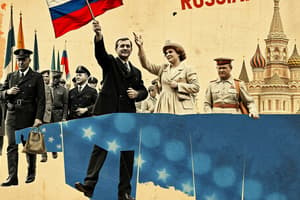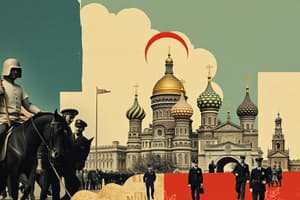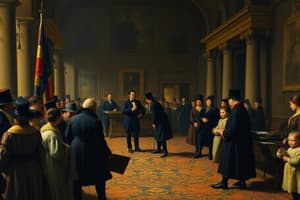Podcast
Questions and Answers
What was one major economic consequence of the war on Russia by February 1917?
What was one major economic consequence of the war on Russia by February 1917?
- Severe inflation and goods shortage. (correct)
- Significant foreign investment.
- Surplus in agricultural production.
- Increase in the standard of living.
How much did Russia's wartime foreign debts total by October 1917?
How much did Russia's wartime foreign debts total by October 1917?
- 8 billion roubles. (correct)
- 20 billion roubles.
- 38 billion roubles.
- 3 billion roubles.
What happened to the value of the rouble between February and October 1917?
What happened to the value of the rouble between February and October 1917?
- It became the strongest currency in Europe.
- It increased by 50%.
- It remained stable.
- It decreased significantly. (correct)
What was a direct result of the Provisional Government's decision to increase the supply of banknotes?
What was a direct result of the Provisional Government's decision to increase the supply of banknotes?
By how much did economic output per head decrease from 1913 to 1917?
By how much did economic output per head decrease from 1913 to 1917?
What trend was observed regarding public debt during the Provisional Government period?
What trend was observed regarding public debt during the Provisional Government period?
Which economic condition in Russia was notable by 1919?
Which economic condition in Russia was notable by 1919?
What was referred to as the 'dance of the billions' during this period?
What was referred to as the 'dance of the billions' during this period?
What economic issue did Russia face by 1917 primarily due to territorial losses?
What economic issue did Russia face by 1917 primarily due to territorial losses?
Which social change was introduced by the Provisional Government during its time in power?
Which social change was introduced by the Provisional Government during its time in power?
What was one major challenge faced by the Provisional Government by the end of its rule?
What was one major challenge faced by the Provisional Government by the end of its rule?
What happened to the social hierarchy as a result of the fall of Tsarism?
What happened to the social hierarchy as a result of the fall of Tsarism?
Which freedoms were guaranteed during the Provisional Government's rule?
Which freedoms were guaranteed during the Provisional Government's rule?
By how much time did the Russian economy stabilize after the civil war?
By how much time did the Russian economy stabilize after the civil war?
What role did the army play during the time of the Provisional Government?
What role did the army play during the time of the Provisional Government?
What was one consequence of the removal of censorship during the Provisional Government's time in power?
What was one consequence of the removal of censorship during the Provisional Government's time in power?
Flashcards are hidden until you start studying
Study Notes
Economic Changes in Russia under the Provisional Government
- Russia experienced significant decline between 1913 and 1919, reverting to economic standards akin to the Middle Ages.
- By February 1917, Russia faced impending collapse despite being wealthy in 1914, largely due to the strains of World War I.
- Key issues included rampant inflation, severe food shortages, public debt, and a broken transport system.
- Foreign debts skyrocketed, totaling over 8 billion roubles by October 1917, alongside 3 billion roubles of pre-war debt.
- The government resorted to increasing banknotes in circulation, causing drastic depreciation of the rouble from 30 kopecks to 6 or 7 by October 1917.
- Estimated wartime costs fluctuated between 38 and 50 billion roubles, leading to national economic insolvency.
- Economic output per capita fell by one-fifth from 1913 to 1917 due to workforce depletion as workers enlisted for military service.
- Loss of economically vital territories like Poland and Ukraine exacerbated the economic crisis.
- The Provisional Government emerged during a severe economic downturn but lacked the relative power to implement effective reforms.
- The economy remained unstable until 1924, post-Civil War, indicating lasting impacts extending beyond the Provisional Government’s rule.
Societal Changes in Russia under the Provisional Government
- The Provisional Government introduced political and personal freedoms, easing prior constraints.
- Citizens gained rights to vote, strike, assemble, and express political views without censorship.
- An eight-hour workday was instituted, improving labor conditions.
- Despite formal freedoms, societal conditions remained harsh; rationing and wartime suffering continued.
- The social hierarchy was disrupted; the nobility lost significant power and land as land was appropriated by peasants.
- The lack of censorship and secret police marked a significant shift in personal freedoms, creating the freest environment seen during this period.
- Increased freedoms allowed some groups to challenge the Provisional Government, leading to turbulence in governance and social dynamics.
Studying That Suits You
Use AI to generate personalized quizzes and flashcards to suit your learning preferences.
